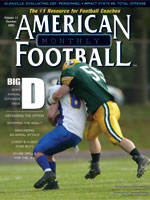AMERICAN FOOTBALL MONTHLY THE #1 RESOURCE FOR FOOTBALL COACHES
Article CategoriesAFM Magazine
|
The Wing-T vs. Multiple Defensesby: David Purdum© More from this issue For defensive coordinators, there is no peskier offensive scheme than the good, old Wing-T. They keep trying to pop that guard trap over and over. Then right as your linebackers have forgotten what a pass looks like, they go play-action. Absolutely aggravating. Western Branch High School (Chesapeake, Va.) Head Coach Lew Johnston is a pesky Wing-T guy. Orchestrated 75-percent of the time out of the shotgun, Johnston’s T really drives D.C.’s crazy. Pearl River High School (LA) Head Coach Joe Harris is also a pesky Wing-T guy. He actually gets excited calling the guard trap. “It’s like throwing the bomb,” Harris says. University of Alabama-Birmingham D.C. Wayne Bolt says to stop those pesky Wing-T guys, you have to throw a change-up at them. Bolt’s Blazers boasted the second best rush defense in Conferenc....The full article can only be seen by subscribers. Subscribe today!
|
|
|||||||
| HOME |
MAGAZINE |
SUBSCRIBE | ONLINE COLUMNISTS | COACHING VIDEOS |
Copyright 2025, AmericanFootballMonthly.com
All Rights Reserved





